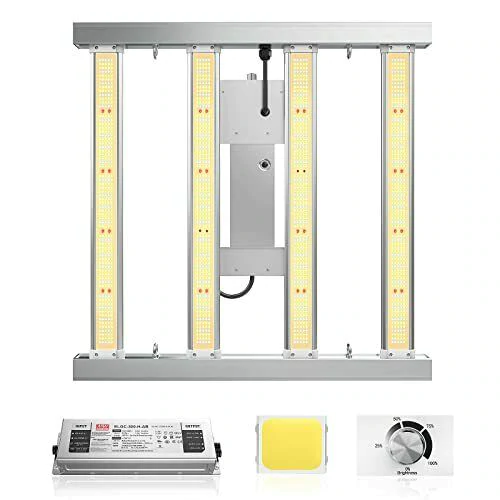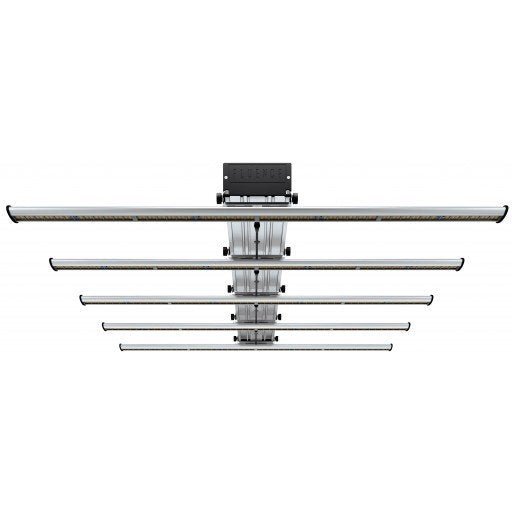Living in an apartment practically devoid of sunlight or in a house with an eastern exposure doesn’t mean you’re stuck with all low-light plants or have to forgo indoor gardening entirely. All that’s required to diversify your plant collection or start seed trays is a grow light. Though many are purely functional and prioritize tech over design, there are also options disguised as home lighting that will accent your décor and keep your plants happy to boot. We’ve rounded up a fantastic selection of grow lights for you to consider, so read on for our recommendations plus everything you need to know before buying.
What Kind of Grow Light is Best?
Lighting options are wide-ranging, from fluorescent to HID (high-intensity discharge) to LED (light-emitting diode). Each type has an array of power requirements, brightness levels, and color temperatures.
Fluorescent lights are an effective supplement to natural (window) light. Traditional fluorescent bulbs are tube-shaped and fit into specialized fixtures; Compact Fluorescent Lights (CFLs) are corkscrew-shaped and feature the same screw-in base that incandescent bulbs do, which allows them to fit into most household fixtures. Fluorescent lights put off minimal heat and a good amount of light, but are not as efficient or long-lasting as LEDs.
High-Intensity Discharge (HID) lights are ideal for growing maturing edible plants. However, HIDs are expensive, use electricity inefficiently, and give off quite a bit of heat. Despite this, they are widely used in plant nurseries and large-scale grow houses because of their raw power.
Light-Emitting Diode (LED) lights: For efficiently growing large numbers of plants, LED grow lights provide the best results. They use significantly less power to produce more light than traditional CFLs, and they produce very little heat. Although LEDs have traditionally been more expensive than fluorescent bulbs, the lifetime of an LED bulb is far longer and their up-front cost has begun to drop in recent years.
Fluence SPYDRx 340W LED Grow Light
Features:
This Fluence grow light has high efficiency, low profile, for 730 umol/s, 2.15 umol/J at 340W as a vegetative stage, top-lighting solution for commercial or as a full-cycle top-lighting solution for residential applications without CO2 supplementation. Full Spectrum PhysioSpec Indoor for optimal photosynthetic targeting. This grow light only consumes 340w, running 50% less power than the HPS /MH and getting maximum higher yields. Veg Coverage is 3 x 4 ft, Flowering Coverage is 3 x 3 ft. The intensity of light can be adjusted according to the stage of plants. Excellent full-spectrum LED grow lights deliver optimal light-spectrum coverage for your blooms, The blue light can shorten your flowering period. A full spectrum increases the quality of your crop. not only cost-effective but also produces better yields.
MAXSISUN MG3000 300W LED Grow Light

Features:
This MAXSISUN LED grow light uses top components with Samsung diodes and MeanWell driver with a bar light design. It is our most professional LED grow light that fits perfectly into a 3x3 ft space from seeds to harvest. The MG3000 consumes only 300 watts, offers a truly high efficacy rating of PPF per Joule 2.4 μmol/J, empowering plants with plentiful and evenly PAR distribution without hot spot. Keep the same distance between plants and the MG3000. Adjust its brightness for different growing stages. We provide a PAR map including brightness, hanging height, and power draw. A smooth rotary dimmer offers flexibility to reduce the amount of energy while reducing your electricity bill. It helps you master light levels from normal daylight to super bright.
Things to consider before buying an LED grow light
While just about every plant loves light, they don’t all have the same taste. Here are some things to consider when buying an LED grow light.
Power consumption
Even though LEDs are much more efficient than their older counterparts, they still require a constant stream of energy to run. And leaving them on all the time — especially if you’re running a lot of them — can really start to ramp up the ecological impact and your electric bill.
Older bulbs used to measure power in watts, but LEDs don’t quite work like that. Input power on an LED suggests how much power it’ll use, but not necessarily how bright it will be. High-efficiency LEDs can put out a lot of light with a few lamps, while other arrays use a higher number of smaller lamps.
Your needs are specific to your plants, but don’t go buying an LED light array just because it has a high wattage rating. Look for an equivalent wattage number or other methods of measurement.
Spectrum coverage
Full-spectrum lights can mean different things depending on the model. True full-spectrum lights include infrared modules that emit waves you can’t technically see. Different light wavelengths often serve different parts of the growing process, so you’ll want to match up the spectrum performance with the plants you’re trying to grow. If your plants aren’t picky, most “full spectrum” lights should do a fine job. But, it’s worth doing a little research about your specific plants to make sure the light you’re buying offers what they need.
Dimmability
Not all grow lights are dimmable. Some have either an on or off setting and not much else. Other LED grow lights can offer ten or even more different levels of illumination so you’re not always blasting them on full power.
Self-timers
Plants don’t need light 24 hours per day, so you’ll want to turn lights on and off as needed. Some lights have built-in timers that allow you to program in a custom schedule. That absolves you from having to remember to hit the switch, which can have a profound effect on plants, especially if you’re trying to start outdoor plants inside.
Conclusion
Whether you’re an indoor plant enthusiast or someone who’s passionate about growing your own food, indoor grow lights are an incredibly valuable tool. Regardless of where you live, a high-quality grow light will allow indoor plants to grow all year-round. And best of all, they’ll help you grow the healthiest and happiest plants than ever before.
I hope this post has given a better idea of which grow lights best meet your indoor gardening needs. Happy gardening!
